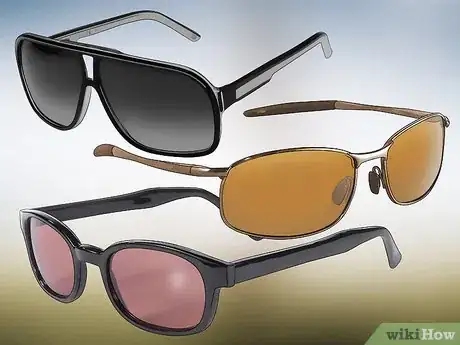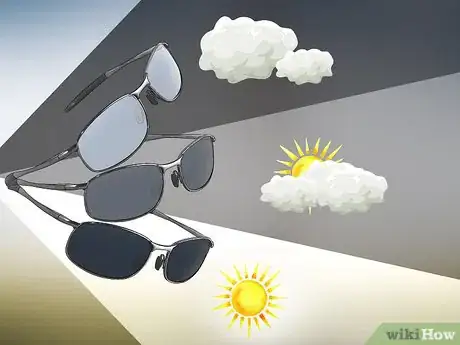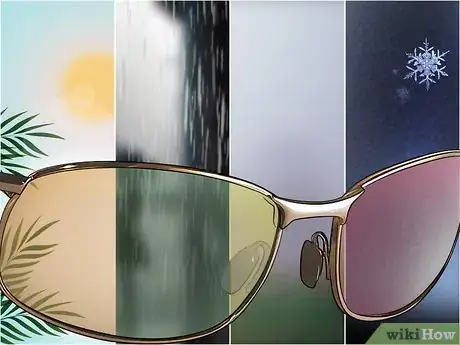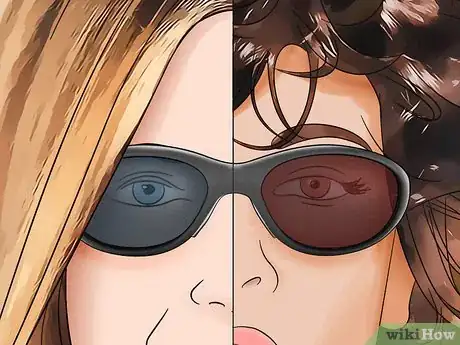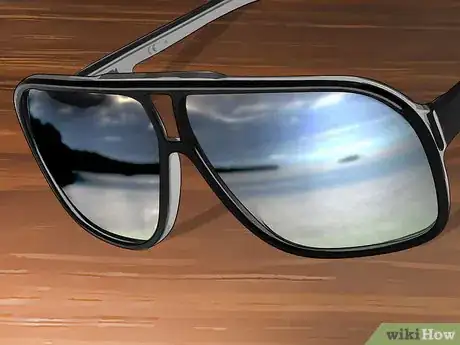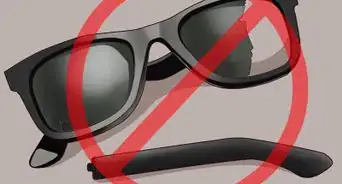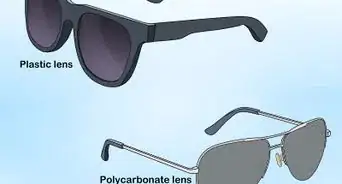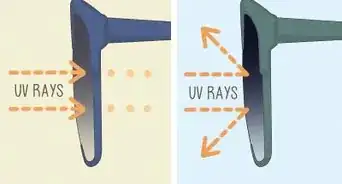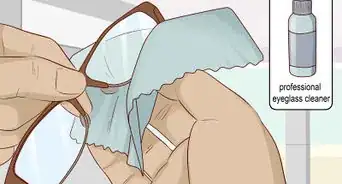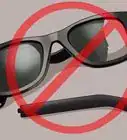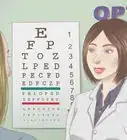This article was co-authored by Sarah McDonald. Sarah McDonald is a Certified Stylist and Image Consultant and the Owner of Pivotal Style. She helps both men and women feel confident through clothing by guiding them on how to dress based on body type, color tone, lifestyle, and personal and professional goals. Sarah received her Image and Style Professional Certification from The Fashion Stylist Institute.
There are 20 references cited in this article, which can be found at the bottom of the page.
wikiHow marks an article as reader-approved once it receives enough positive feedback. In this case, several readers have written to tell us that this article was helpful to them, earning it our reader-approved status.
This article has been viewed 81,966 times.
Sunglasses come in a wide variety of lens colors. The most common are gray, black, brown, green, yellow, orange, amber, and red. When shopping for sunglasses, you should think about what type of lens is best for your lifestyle. Shopping around to find the pair that fits you best is important, but you should also factor in your daily activities, such as driving, exercising, and medical care. For some people, however, lens color is purely a fashion choice, and so you might want to think about what color looks best on you.
Steps
Trying Out Your Options
-
1Try on different colors. You might find that certain colors are more comfortable for your vision than others. While shopping for new sunglasses, you should try on pairs with various lens colors. Many opticians and sunglass stores will carry lenses in various shades that you can try on. You may find that there are certain differences between these colors, such as:
- Gray, brown, and green lenses are neutral. They decrease glare and eyestrain without distorting colors.
- Yellow, amber, and orange lenses increase contrast, but they may distort color. They also block out blue light, which some believe may be harmful for the eyes.
- Red or rose tinted glasses increase contrast, but they distort color more strongly than other shades.[1]
-
2Consider photochromic lenses. Photochromic lenses are those that change colors based on how much light they are absorbing. These glasses can adjust from bright conditions to dim ones, although they do take a few minutes to adjust. They are also more expensive than a normal pair of prescription glasses, although they eliminate the need for a separate pair of sunglasses.[2] If you wear prescription glasses, you might consider investing in a pair so that you do not have to switch between glasses in middle of activities such as driving.[3] Typically, photochromic glasses will darken into neutral colors such as gray.Advertisement
-
3Go for medium darkness. You should aim for a tint that is about medium darkness; if you can see your eyes when looking in a mirror, they may not be dark enough.[4] You do not need to buy the darkest lenses unless you live in a very bright area. Darker lenses do not necessarily block more UV rays, but they may make it more difficult for you to see. It is important that you get glasses you can see clearly in.[5]
-
4Invest in several pairs. If you need different types of colors for different activities, you might consider buying a few pairs of glasses in different shades. You might have one pair for driving and another for sports. If you play several sports, you might find that you have a different pair for each activity.[6]
Identifying the Best Color For Your Needs
-
1Think about when you use sunglasses. The type of activity you’re doing may determine the right color of sunglasses for you. Consider when you wear your sunglasses most. While every shade of sunglasses will protect your eyes from UV rays and help you see during bright days, certain colors may improve the efficiency of certain tasks.
- For driving, gray and brown work best to block out colors. Yellow and amber are not recommended because they may distort the color of traffic signals.[7]
- For pilots, gray, green-gray, or brown lenses are recommended.[8]
- If you need glasses for boating or fishing, try wearing pink or rose-tinted glasses.[9]
-
2Factor in your local weather. Think about the climate where you live. Different colors or shades will be more effective in different types of weather. If you live in a tropical area, you might want a color that is better for bright sunny days. If you live in the north, you might find that you need a good pair of sunglasses for snowy weather.
- Brown, amber, and gray are great for sunny or overcast days.
- Greens are good for most weather conditions, including rain.
- Yellows are great for foggy or hazy conditions, including heavy air pollution.
- Reds, pinks, blues, and purples are good for snowy and misty conditions.[10]
-
3Match your sunglasses to your sport. Certain colors may give you an edge if you play sports. Finding the right color lens for your sport can help filter out obtrusive colors and help you notice minute details. Some good options include:
- Tennis: gray, brown, or yellow are best.[11]
- Golfing: yellow, amber, and brown are good for general games. Red and rose may be good for the putting green but not on the fairway.[12]
- Skiing: amber, yellow, or orange are generally recommended.[13] Rose colored lenses may help in low-light conditions.[14] .
- Running: Brown, yellow, or rose are good options, although neutral colors such as gray and green work well too.[15]
- Baseball: amber, brown, or green are recommended.[16]
-
4Ask your doctor for advice. If you have any eye conditions—such as glaucoma or cataracts—, you should speak to your doctor about what color lens is right for you. You may be advised to find a neutral lens that will block out harmful UV rays without distorting color very much, or you might be recommended a yellow or amber lens to improve your contrast.
- For glaucoma, mirror coatings can be helpful. These are shiny outer coatings that reduce glare but do not distort colors. They come in almost every color, but unlike normal lenses, the color of the mirror coating has no effect on your vision.[17]
- If you have macular degeneration, amber lenses may help while outdoors. While driving, you should stick with gray lenses, however.[18]
Finding a Color that Fits Your Style
-
1Consider your complexion. If you have a cool complexion, you will want a different color lens than someone who has a warm complexion. Determine your skin tone. If you have pink or blue undertones, you have a cool complexion. If you have yellow undertones, you have a warm complexion.
- Cool complexions might want to choose blue, purple, rose, gray, or green tinted lenses.
- Warm complexions may want to choose red, yellow, brown, amber, or orange colored lenses.[19]
-
2Stay classic with a neutral tone. If you want a vintage or classic look, you should stick to neutral tones such as brown, gray, dark gray, or green. These colors do not go out of style, and they draw the attention to the shape of your glasses instead of to the tint.[20]
-
3Add some flash with a mirror-coated lens. A mirror-coated lens has a shiny outer layer that gives your sunglasses a polished gleam. Mirror coatings can reduce glare without distorting any color. You can choose almost any color for your mirror-coating without it affecting your vision. Some even come in multiple colors.[21]
- You can buy glasses with mirror coating already applied or you can ask your optician to fit your frames with mirror-coated lenses.
-
4Try soft, pastel lenses. If you do not like how dark sunglasses are, pastel lenses are another option. These stylish lighter shades may not block out much light, but they will give you a cool, summery look. Lighter shades can still block out UV rays so look for a pair that is labeled as providing 100% UV protection.[22] Some shades that you might consider are:
- Light orange
- Rose
- Lavender
- Soft blue
- Light gray
Warnings
- Yellow or amber glasses may distort colors, making it difficult to identify traffic signals. They are not recommended for driving or flying.⧼thumbs_response⧽
- No matter how dark your sunglasses are tinted, never look directly at the sun with them on.⧼thumbs_response⧽
References
- ↑ http://share.upmc.com/2014/06/guide-to-selecting-best-sunglasses/
- ↑ http://www.allaboutvision.com/lenses/photochromic.htm
- ↑ http://lookafteryoureyes.org/eye-wear/sunglasses/
- ↑ http://www.glaucoma.org/treatment/a-guide-to-sunglasses.php
- ↑ http://www.aao.org/eye-health/tips-prevention/top-sunglasses-tips
- ↑ http://www.allaboutvision.com/sportsvision/lens-tints-chart.htm
- ↑ http://share.upmc.com/2014/06/guide-to-selecting-best-sunglasses/
- ↑ https://www.faa.gov/pilots/safety/pilotsafetybrochures/media/sunglasses.pdf
- ↑ http://www.westmarine.com/WestAdvisor/Selecting-Sunglasses-for-Boating
- ↑ https://www.vsp.com/lens-tints.html
- ↑ http://www.hixmagazine.com/lens-color-guide-infographic-for-sports-sunglasses/
- ↑ http://golftips.golfsmith.com/sunglasses-lens-color-golf-20313.html
- ↑ http://www.allaboutvision.com/sportsvision/lens-tints-chart.htm
- ↑ http://www.hixmagazine.com/lens-color-guide-infographic-for-sports-sunglasses/
- ↑ http://www.hixmagazine.com/lens-color-guide-infographic-for-sports-sunglasses/
- ↑ http://www.allaboutvision.com/sportsvision/lens-tints-chart.htm
- ↑ http://www.glaucoma.org/treatment/a-guide-to-sunglasses.php
- ↑ http://www.brightfocus.org/macular/article/how-choose-right-sunglasses
- ↑ http://www.sunglasswarehouse.com/blog/sunglasses-for-skin-tone/
- ↑ http://www.artofmanliness.com/2014/08/12/how-to-pick-aviator-shades/
- ↑ http://www.allaboutvision.com/faq/sunglasses.htm
- ↑ http://www.today.com/style/debunking-9-common-myths-about-sunglasses-2D80554300
- ↑ http://www.webmd.com/eye-health/features/how-to-pick-good-sunglasses#2
About This Article
To choose the right sunglass lens color, consider your needs and style preferences. Gray, brown, and green lenses decrease glare and eyestrain without distorting colors. Yellow, amber, and orange lenses increase contrast but can distort colors. Pink or rose tinted glasses increase contrast but also distort color more than other shades. When trying on sunglasses, you shouldn’t be able to see your eyes in the mirror, which means they’re blocking enough UV rays. If you need sunglasses for driving, go for gray or brown lenses. If you need them for boating or fishing, try pink or rose-tinted glasses. You should also factor in your local weather. Brown, amber, and gray are great for sunny or overcast weather. Greens are good for most weather, including rain. Reds and pinks are best for snowy and misty conditions. For more tips, including how to choose the best sunglass lens colors for running, skiing, or golfing, read on!
